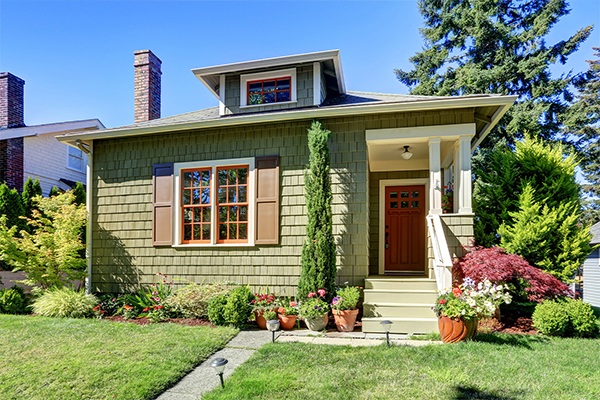How to Use Your 401K to Buy a House

Key takeaways:
- You can withdraw funds from your 401K account to pay for a primary residence. However, penalties and taxes will apply.
- Depending on the specifics of your account, you may also be eligible to take out a home loan of up to $50,000 against your 401K.
- To keep your retirement savings intact, consider other options for your down payment and closing costs.
Should You Use 401K to Buy a House?

As a first-time home buyer, you may be concerned with all the costs associated with purchasing a primary residence.
Perhaps you can easily afford the monthly payment on your dream home, but it’s the down payment that worries you. The down payment is the portion of the purchase price paid upfront, generally 3-10% for first-time home buyers. On top of that, you could pay another 3-6% of the purchase price in closing costs.
Coming up with enough cash to cover the down payment and closing costs is a significant hurdle for many first-time buyers. So it’s natural to consider using the savings in your 401K retirement account.
If you’re wondering about your 401k first-time home buyer options, this is your guide.
Ways to Use Your 401K

First things first—let’s go over the purpose of a 401K.
401Ks are retirement savings accounts. The government wants people to save for retirement, which is why it allows you to put a portion of your paycheck into your savings account without paying any taxes on that money. In turn:
- You are not supposed to make withdrawals until you are 59 ½ (although if you’ve lost or quit your job, you can withdraw funds at 55).
- Because these accounts are meant for retirement, there are penalties for early withdrawal.
- You will also have to pay taxes on any withdrawn funds.
However, your 401K account is ultimately filled with your money, and you can use it to buy a house, although doing so can result in a net financial loss.
Depending on the specifics of your plan, you may have two options for using the money: withdrawing it or taking out a loan against the funds. In both cases, there are 401K first-time home buyer IRS considerations.
Next, we’ll take a closer look at the pros and cons of each method.
First-Time Home Buyer 401K Withdrawal
You can make a withdrawal from your 401K account. This will be classified as a
“hardship withdrawal.”
Be aware that you will generally pay a 10% penalty, and 20% of the withdrawal will be withheld for taxes. 401K withdrawal can come with financial losses:
- If you need $25,000 for your home, you’ll need to take out $31,250
- Then, you’ll also pay an additional 10% penalty of $3125
- In total, you’ll lose $34375 of your retirement savings
There are some exemptions for 401K withdrawals that allow you to take out money without paying a penalty. These include:
- Medical expenses
- Savings rolled into another retirement account
- COVID-19 relief
Unfortunately, there is no 401K first-time home buyer exemption.
First-Time Home Buyer 401K Loan
Alternatively, you may be able to take out a loan equal to half your 401K savings or $50,000 (whichever is less). When you take out a loan, you won’t be charged a 10% penalty, nor will 20% in taxes be withheld.
- If you need $25,000, you can simply take out a loan for $25,000 (assuming you have at least $50,000 in the account).
- However, keep in mind that you will have to pay yourself back. In addition, you will pay interest on the loan.
- If you need more, apart from the loan you could also make a withdrawal. The penalties outlined above would apply for what’s withdrawn.
While this option may be less costly than taking out a withdrawal, the interest on your loan repayment will have a cost.
Check with your financial institution to see if your plan allows 401K loans.
Alternatives to Using Your 401K
While using your 401K may seem like an easy solution, you can pay steep penalties—not to mention the fact that you’ll be depleting your retirement savings.
- If you keep $34,375 in your 401K account, it could grow significantly over the course of the next few years.
- If you withdraw it to put $25,000 towards your home, you’ll experience an immediate loss plus a loss of potential future dividends.
There are other good options for covering your down payment and closing costs. These include:
- Making an IRA withdrawal – You may be eligible to withdraw up to $10,000 from your Roth IRA to put toward a first home. You can make this withdrawal without paying a penalty or being taxed.
- Researching grants – Some states, cities, and counties offer grant incentives for qualifying first-time home buyers. Depending on the nature of the grant, you may be able to use it for your down payment or closing costs.
- Taking out a loan from another source – Other government-sponsored programs can help you take out a loan to cover a portion of your closing costs or down payment. Some offer loans that are forgiven after a certain time period or repayable only after the sale of the home. Others carry interest rates as low as 0%.
Thoroughly research your local resources to see if you’re eligible for programs that could prevent the need for a 401K withdrawal.
Invest in Your Long-Term Financial Health
Buying a home can be a great long-term investment. You’ll enjoy the benefits of homeownership now and can look forward to paying off or selling your home to get ready for your retirement plan.
While it’s tempting to use your 401K and dive into homeownership, there are downsides. You’ll face penalties and losses whether you withdraw funds from the account or take out a loan.
Be sure to research all available options before you withdraw any funds from your retirement account. That way, you’ll keep yourself on the path toward enjoying your golden years in your very own home.






